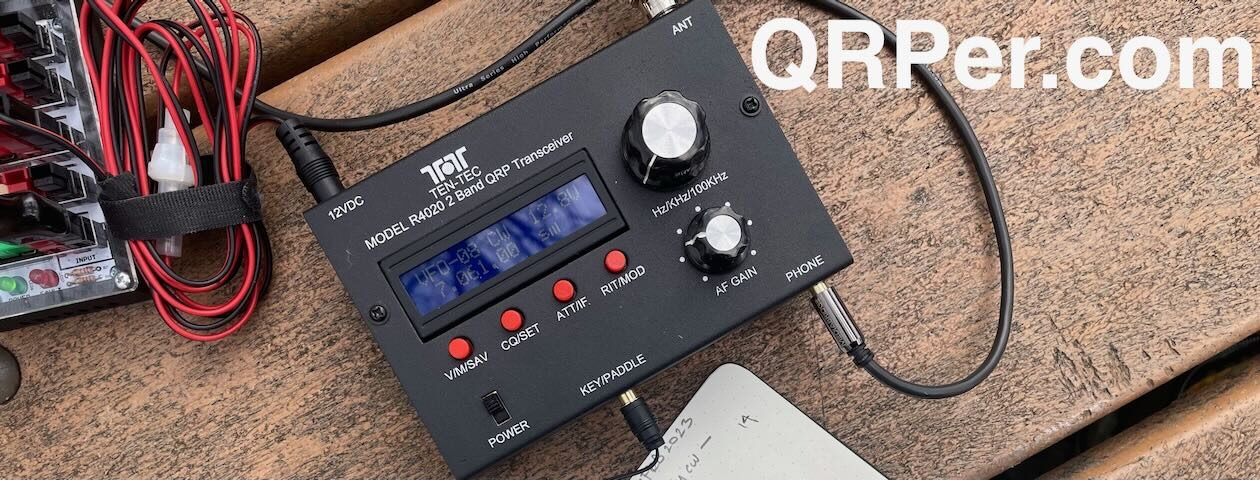Many thanks to Paul (W0RW) who shares the following field report:
 Exploring the 7 Lakes Wilderness Area
Exploring the 7 Lakes Wilderness Area
It was as a dark and drizzly morning as my XYL (Sharon) and I (Paul) went up to Cripple Creek, Colorado, and then drove down the Gold Camp Road. The colorful Aspen trees were changing color and even in the drizzle had brilliant yellow and red colors. We proceeded up Fire Road 376 to 11,000 feet, The entrance gate to 7 Lakes. The South Slope Ranger opened the gate for us and checked our registration. I got out the rain and snow gear and got my poncho on.
(My radio is waterproof).
I don’t normally operate in the rain and snow but this area is available only by pre-registration. The day I picked happened to be a Hurricane remnant day.
The area was just opened to the public this year and there are only 20 cars authorized per day. The area has been closed to the public since 1913–before wireless! This was opening day so I picked the Special Call Sign, ‘W7L’, to operate with because it is the tri-graph of the name of the area, Wilderness 7 Lakes.
 We set out on the trail for Mason Reservoir. As we arrived at the reservoir a snow cloud descended on us accompanied by thunder snow. There were 6 people there already fishing. They said fishing was great, mostly ‘catch and release’. One of the lady fishermen saw the big 10 foot whip on my back pack and asked me if I would like her spot on the lake to fish. I told her I was working ‘catch and release’ on 20 meter CW and I didn’t have a fishing license.
We set out on the trail for Mason Reservoir. As we arrived at the reservoir a snow cloud descended on us accompanied by thunder snow. There were 6 people there already fishing. They said fishing was great, mostly ‘catch and release’. One of the lady fishermen saw the big 10 foot whip on my back pack and asked me if I would like her spot on the lake to fish. I told her I was working ‘catch and release’ on 20 meter CW and I didn’t have a fishing license.
The radio I was using was my 30 pound PRC319 backpack radio which runs 50 watts.
The trail head has a new restroom and a covered picnic table area with one tree nearby for picnic table operations. This is a deep valley (That’s where most reservoirs are kept). So you might need more than 5 watts to get over the hills.
If you have ever taken the COG Railway out of Manitou Springs to the top of Pikes Peak, you have probably seen this area from the “Son of a Gun” Hill.
Warnings: These are high altitude trails; you must be in good physical condition to hike. Elevations at 7 Lakes range start at 11,000 feet; if you are arriving from a low elevation consider acclimating at 6,000 feet for one or two days.
Bring plenty of water and pace yourself. Altitude sickness is common. Symptoms can be shortness of breath, nausea, dizziness, headache, dyslexia. Also Loss of clear thought processes like: locking your keys in your car (This happened to one of the fishermen), leaving your log on a rock, forgetting how to program your radio, forgetting your operation time schedule or what the upper band limit of the 17 meter band is.
WG0AT, Steve, was with me on my second trip and he made this cool video:
Click here to view on YouTube.
Then he took a side trip from 7 Lakes and went up the adjoining 12,000 foot, Almagre mountain. See the history at : http://en.wikipedia.org/wiki/Seven_Lakes,_Colorado
You can reserve your place there by applying at the Colorado Springs web site:
https://coloradosprings.gov/southslope?mlid=29236
Paul (W0RW)
Wow, Paul! That sounds absolutely brilliant! And taking a PRC-319–? Wow! What a way to add a little extra challenge to your high altitude radio adventure!
Thank you for sharing this, Paul!


















































